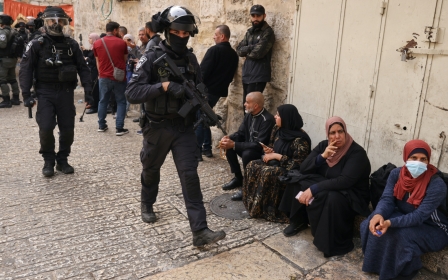UK government used Dome of the Rock image to promote Israel free trade deal

The UK’s Department for International Trade has admitted that it mistakenly used an image of the Dome of the Rock in Jerusalem’s Old City on the cover of a document promoting a prospective free trade agreement with Israel.
The document was hurriedly changed after British government officials were alerted to a Twitter post by Middle East Eye contributor Chris Doyle pointing out that the golden-domed shrine is in occupied territory which is not recognised by the UK as part of Israel.
The image featured on the cover of an information note published on the UK government’s website on 1 February as part of material relating to a consultation “to help inform our approach for starting negotiations on a free trade agreement with Israel in the future”.
The document also included another image of the Dome of the Rock, which stands in al-Aqsa Mosque complex and is one of Jerusalem’s most recognisable landmarks, on its introduction page.
But the document was flagged up to senior officials in the Department for International Trade on 10 February, shortly after Doyle, director of the Council for Arab-British Understanding (Caabu), had posted a link to it on Twitter, according to an email exchange obtained by MEE via a freedom of information request.
In an email at 4.27 pm GMT, a government official whose name is redacted in the emails seen by MEE sent a link to Doyle’s tweet to Ros Lynch, the deputy director of the Department for International Trade.
“Is there any truth to it?” the official asked, before suggesting that unnamed others, whose details are also redacted, were “ready to update the image asap as needed”.
Replying at 4.34 pm GMT, Lynch wrote: “I do not know who chose that image but would agree that it should be changed.”
The unnamed government official then suggests that the choice of the image may have been signed off by officials in British Prime Minister Boris Johnson’s office at 10 Downing Street.
“Ok – not sure who else to flag with then, as of course, this would have been signed off by policy (never mind no.10). Perhaps one for the country team?” they reply.
“Who can we check new images with now?”
The document was republished the next day with images of office towers and the Tel Aviv skyline replacing those of the Dome of the Rock.
In a letter in response to MEE’s freedom of information request, the Department for International Trade said: “The change was to replace the image of the Dome of the Rock which was mistakenly used when the document was first published.”
Israel claims Jerusalem as its capital but its continuing occupation of East Jerusalem and the Old City since its 1967 war with neighbouring Arab states is considered illegal under international law.
The website of the British Consulate in Jerusalem, which represents the British government in the occupied Palestinian territories, states the UK’s position on the status of Jerusalem.
“The position of the UK government has remained constant since April 1950, when the UK extended de jure recognition to the State of Israel, but withheld recognition of sovereignty over Jerusalem pending a final determination of its status,” it says.
“We recognise Israel’s de facto authority over West Jerusalem. In line with Security Council Resolution 242 (1967) and subsequent Council resolutions, we regard East Jerusalem as under Israeli occupation.”
Doyle told MEE: “It is extraordinary that a government document was published on UK-Israel trade using an image of a major Islamic site that the UK accepts does not lie in sovereign Israel but in occupied territory.
“One hopes that the government will take far greater care in its determinations on UK-Israel trade and above all not ignore the very serious issues of systematic human rights abuses and the global human rights consensus that Israel is committing the crime of apartheid.”
The Dome of the Rock has been a backdrop in recent days to images of raids by Israeli security forces on al-Aqsa complex in which Palestinian worshippers have been assaulted and blockaded inside prayer halls.
On Friday morning, dozens of people who had spent the night inside the mosque were injured when Israeli police stormed the compound, firing tear gas and rubber-tipped bullets.
Doyle was not alone on social media in criticising the use of the image of the Dome of the Rock in the document.
“Why is al-Aqsa - the third holiest site in Islam & in occupied East Jerusalem - on the front page of this free trade agreement? Is it another ‘mistake’ or is the UK endorsing Israel’s illegal, immoral and belligerent occupation, annexation and its version of apartheid?” Husam Zulmot, the Palestinian ambassador in London, wrote on Twitter.
After the document had been updated, Zumlot wrote: “Good to see al-Aqsa no longer features on this shameless trade document. Regrettable that the UK govt is rewarding violations of human rights at a time when the British people & civil society are actively exposing and opposing Israel’s crimes against humanity including #apartheid”.
Middle East Eye propose une couverture et une analyse indépendantes et incomparables du Moyen-Orient, de l’Afrique du Nord et d’autres régions du monde. Pour en savoir plus sur la reprise de ce contenu et les frais qui s’appliquent, veuillez remplir ce formulaire [en anglais]. Pour en savoir plus sur MEE, cliquez ici [en anglais].






